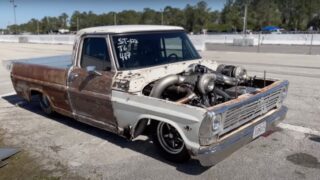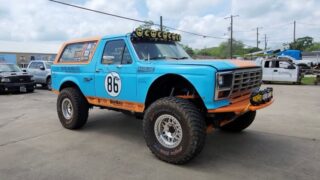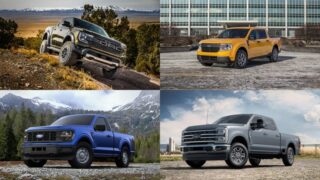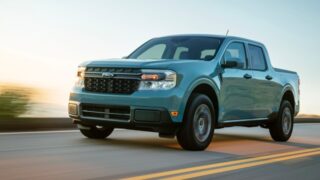|
Special Features
PACKAGE/ERGONOMICS/CONVENIENCE
“You could say we’ve designed the new Explorer from the inside out.
Giving customers one of the most spacious and user-friendly
interiors of any SUV was a key driver throughout the vehicle’s
development. It led us to develop new and innovative ways to
maximize space and utility.”
– Gary Langner,
Explorer Packaging Supervisor
- 2.5-inch wider stance improves appearance, handling
and roominess – while maintaining the same vehicle length and height
- New independent rear suspension allows for a new
optional third-row seat, seven-passenger seating capability and
improved ride and handling
- Larger door openings and lower step-in height aid
ingress and egress
- Front seats are located closer to the door openings
- Grab-through handles make opening doors easier
- Power adjustable pedals and tilting/telescoping steering
wheel offer better driver comfort and convenience – and
allow drivers to tailor the vehicle to their individual
needs
- Longer front-seat seat travel improves the seating
position for taller and shorter customers
- New 40/20/40 second-row seat adds flexibility for
carrying cargo and people – and allows easy access to the
third row
- New lower liftover for rear glass makes loading
groceries and cargo easier
- Larger storage features throughout the vehicle enhance
user friendliness
- Relentless attention to details aids ergonomic, comfort,
quality and convenience
- 15-percent improved annual running costs thanks to
easier serviceability and longer intervals between scheduled
maintenance
The 2002 Explorer’s design changes are obvious: bolder profile,
wider stance, longer wheelbase, new front-end, grab-through door
handles, bigger base wheels and tires, and additional ground
clearance – to name a few. But the real design-and-engineering
story is under the vehicle’s skin – and under the floor.
Thanks to an all-new independent rear suspension (IRS) system and
innovative packaging techniques, Explorer has one of the most
spacious interior packages of any SUV. In addition to providing
space for optional third-row seating – which can accommodate two
adults and gives the vehicle capacity for up to seven passengers –
Explorer leads the competition and has an inch more front-row leg
room and 2.4 inches more shoulder room than the previous model.
“Early in the development program, we decided an independent rear
suspension would be necessary to achieve our package goals,” says
Dave Rodgers, Explorer vehicle dynamics supervisor. “IRS not only
provides ride and handling advantages, but it serves as a launching
pad for a host of other improvements, including improved interior
space for passengers and storage.”
The IRS provides significant package advantages because engineers
did not need to leave room beneath the floor _for a conventional
differential to move up and down. In fact, the IRS configuration
permits the rear floor of the vehicle to be lowered nearly 7 inches.
This lower floor allows the new Explorer to offer a third-row seat
with plenty of headroom, without compromising cargo space or
utility. Even with the lower floor, overall ground clearance was
able to be improved an inch – which strengthens the vehicle’s
off-road capabilities.
All-new Third-Row Seat
Explorer’s optional third-row seat creates seating capacity for
up to seven adults and cargo.
Careful attention was paid to the ease of access to the third
row. As a result, the second-row seats can be folded down with one
hand. A pneumatic lifter flips the second-row seats up and out of
the way. A one-hand operation returns the second row to its seating
position. A lever on the back of the second row makes exiting easy
for passengers sitting in the third row.
Likewise, folding the third-row seat easily can be accomplished
with one hand. When both the second and third rows are folded, they
present a flat 45- by 80-inch cargo surface stretching from the
front seats to the liftgate. The area can accommodate building
materials, as well as ski gear and other items for active
lifestyles.
The second-row seat splits 40/20/40 for easy access to the third
row from either side of the vehicle. For cargo carrying, the splits
provide versatility to load long objects on the floor on either side
or in the center.
Regardless of the activity, Explorer’s fold-flat cargo area is
designed for versatility without the struggle of removing seats.
“People have told us over and over that they want the seat to
disappear when it’s folded. They don’t want to have to remove the
seats,” says Gary Langner, Explorer Packaging supervisor.
“Customers also want simplicity and the ability to maneuver the
seats with one hand.”
To keep third-seat passengers comfortable, they have _their own
juice and beverage holders and an optional auxiliary
air-conditioning unit mounted in the ceiling panel.
Third-row passengers aren’t the only beneficiaries of Explorer’s
increased interior space. The driver has more room, thanks to a
longer seat track.
Power Adjustable Pedals, Safety Belts and Steering
Wheel
Power adjustable brake and accelerator pedals are available with
automatic transmission models to further customize the driving
position. The pedals can be moved up to 3 inches. Moving the
pedals closer also allows shorter drivers to raise the seat height
in powered-seat models, to improve forward visibility.
Likewise, adjustable shoulder-belt D-rings in the front and
second rows help to ensure that the safety belt crosses at the most
comfortable point on the shoulder. Explorer’s steering wheel not
only tilts, it also telescopes. The driver can move the wheel up or
down and toward or away to create the optimum driving position.
More Room All Around
Between the front seats, the console is wider due to the driver
and passenger seats being further apart. The glove box also is
larger. The driveshaft tunnel is smaller in the second row to
improve foot room. Third-row passengers have a completely flat
floor underfoot.
The standard overhead console holds sunglasses and a garage door
opener, or the HomeLinkTM system, which can combine the functions of
up to three remote control devices. Between the seats, the
floor-mounted console offers a second-row power plug, along with
heating and cooling vents and cupholders.
All seats are easier to climb into, due to a new body design that
moves the rocker panels inboard, behind the doors. The seats are a
half-inch closer to the ground in Explorer, and closer to the door
opening, which makes them easier to reach. The design also allows
for a wider running board.
Another benefit of Explorer’s roomy new interior is storage
space. Overall cargo volume is increased 7 cubic feet compared with
the previous model – and matches the best of the competition without
added vehicle length.
In addition, dramatically larger storage bins are located in the
rear quarter panels, with plenty of room for flashlights and jumper
cables.
Explorer also offers two under-floor cargo areas in the
five-passenger configuration or one under-floor bin with the
optional third-row seat. The lids for these bins are removable and
waterproof, so they can be used as a ground cover if a driver is
ever faced with changing a tire on muddy terrain.
The new Explorer has 2 more cup and juice box holders than
previously – 8 in total – including two compartments in the front
doors designed specifically to hold water bottles or 20-ounce soft
drinks. Front-door map pockets are larger – enough to hold a
three-ring binder.
New Rear Liftgate Passes ‘Shopping Cart Test’
One feature that helps put the “utility” into the SUV is its
new-design rear liftgate. When designing it, engineers studied how
people use the liftgate and how it could be made to be more
convenient.
The result is a design with a larger liftglass and lower
“liftover” height. The liftgate bottom is designed to serve as a
wall to keep bottles and cans from rolling out onto the parking lot.
The liftgate height is designed for easy loading of groceries. At
43 inches, the load height between the shopping cart and the vehicle
are virtually the same.
“We researched the idea of a low liftover height with customers,”
Langner recalls. “It was a runaway success. We’ve made it as low
as we could while still being able to package the license
plate.”
An Audio System for Most Every Need
Explorer is available with a variety of audio systems – up to a
290-watt audiophile system, which includes a six-disc, in-dash CD
changer with sound tuned to the interior acoustic environment.
The system includes seven speakers, with a 90-watt subwoofer that is
20 percent larger – made possible by packaging improvements – and
two audio tweeters. Other audio options include single-CD and
dual-media CD and cassette systems.
Attention to Detail Aids Ergonomics, Comfort, Quality and
Convenience
In addition to being spacious, Explorer is designed with a
pleasingly modern and ergonomic passenger compartment with high
standards of comfort, quality and convenience.
A full-time ergonomist worked with Explorer’s development team –
ensuring that the layout of controls and displays is clear, logical
and well ordered for maximum usability.
The ergonomics efforts were combined with an analysis of how the
vehicle’s various components relate to one another and contribute to
the overall perception of quality inside and outside the vehicle.
As part of the process, every control an occupant is likely to
touch was tested and retested – and then modified as necessary. One
example is the vehicle’s steering wheel.
“A lot of work went into the steering wheel,” says Sue Maue,
Explorer craftsmanship engineer. “We analyzed in detail its
diameter, cross-section and the placement of the finger detents. As
a result of our exhaustive study, we developed what we think is the
perfect steering wheel for our Explorer customer.”
Because the steering wheel felt so right, it was used as a model
for how everything else in the vehicle should feel. This includes
the grab handles above the doors, which were redesigned with the
same finger grips as the steering wheel.
Other examples of ergonomic improvements include the exterior
door handles, which were changed to a full-grip design that is
easier to grab and pull. Inside, the knobs, buttons and controls
are logically laid out, and the most frequently used controls and
displays – such as those on the audio system and message center –
are located highest on the instrument panel. Graphics for climate
controls are larger for easier readability, and the driver’s side
lumbar adjustment knob is redesigned for easier operation.
“Much of our focus on ergonomics seems like common sense,”
explains Elizabeth Johnston, the development team’s full-time
ergonomist. “Much of it is rather obvious – such as putting the fog
lamp switch next to the headlamp switch or making sure the child
seat tethers aren’t tucked away out of sight.”
In all, Johnston and her team documented 350 areas of
consideration. This included making sure that the liftgate, when
raised, was high enough so tall people wouldn’t hit their heads, yet
is low enough for shorter statured people to reach.
The team made sure the driver would not catch a leg on the seat
adjustment handle or have to look below an angle of 35 degrees to
find instrument panel controls or displays.
Redundant controls for the radio and climate control are located
on the steering wheel and are lighted for easy access and
readability. Tactile cues on the control buttons make it possible
to use them without glancing down. Interior map and courtesy lights
are placed and aimed to provide an even level of illumination from
every seating position.
The front-seat climate controls have optional dual-zone controls,
which allow both the driver and passenger to specify separate
temperature levels. An auxiliary climate control system is
available for the rear seating area. Air ducts are shaped to speed
the flow of heated or cooled air for faster response. Solar glass
and privacy glass, including an available moon roof, help to shield
the interior from the sun’s heat, while keeping possessions safe
from prying eyes.
The windshield washer reservoir is larger – enough to hold more
than a gallon of fluid. Likewise, the fuel tank was relocated to
the right side of the vehicle, which allowed it to be made larger
and hold 1.5 more gallons of fuel. The fuel gauge sensor was moved
to the middle of the tank to help ensure the most accurate readings.
Auxiliary power points in the front console and second row
seating area accommodate plug-in accessories, such as phones, games
and air pumps. Devices such as the radio and power windows remain
functional up to 10 minutes after the ignition is turned off, but
accessory power is cut during starting to ease strain on the
battery. Likewise, a battery saver function turns off interior
lights approximately 10 minutes after the ignition is switched off
to help prevent drain.
A larger rear wiper offers better rear visibility in inclement
weather. An approach lamp in the bottom of each side mirror
illuminates the vehicle at night.
Wider, more substantial optional running boards provide convenient
access to the interior. A sturdy roof rack offers a place to carry
bulky items that don’t fit in the fold-flat rear cargo area. The
roof rack has adjustable crossbars and tie-downs and is rated to
carry 200 pounds. With available accessories, it can carry
bicycles, up to six pairs of skis or four snowboards, a kayak or
canoe.
Even the coat hooks were scrutinized and modified.
“We had a big session one day on coat hooks,” Johnston explains.
“Everyone was asked to bring in his or her cleaned laundry, and hang
it in a vehicle. We noticed that the big, plastic hangers that are
becoming so common don’t fit very well on traditional hooks. But
they do now in Explorer.”
Another small detail: the key fob. Most key fobs for cars have a
button with a picture of a trunk popping open to label the trunk
release button. For a while, most SUVs did not offer such a
convenience.
“We now have an SUV liftgate button,” Johnston says. “You push
it, and the liftglass opens.”
Low-Cost Ownership Drives Design for Serviceability
Attention to detail doesn’t end with the Explorer’s development.
Significant attention has been paid to the vehicle’s entire service
life – especially keeping service requirements and ownership costs
to a minimum.
Serviceability was considered very early in the vehicle’s
development. Engineers studied the vehicle’s scheduled maintenance,
such as oil changes, and a market basket of the 22 top unscheduled
repairs. The goal was to reduce overall ownership and maintenance
costs.
The result is a nearly 15-percent – or $100 – reduction in
service costs over five years. Explorer’s recommended service will
cost an estimated $604 over five years, compared with more than $700
for the previous model.
The lower service costs are due to such changes as the
elimination of transmission fluid changes at 30,000-mile intervals.
The transmission is now sealed from the factory with 11 quarts of a
semi-synthetic blend of specially formulated fluid that should not
require changing for the first 150,000 miles.
In addition, as part of Explorer’s new independent rear
suspension system, a large inspection port has been installed in the
differential, so the gearing can be inspected by putting the
Explorer on a hoist. This will represent a major savings in
diagnostic labor costs compared with removing the unit to a
workbench.
The steering gear also is now easier to service, reducing labor
from 1.6 to 1.0 hour, which represents an estimated $36 repair
savings to the customer. Headlamp service also is easier – and will
cost $15 less at typical repair rates.
# # #
08/04/2000
EMBARGOED UNTIL AUG. 4, 2000
NVH
“We listened to every area of Explorer to make dramatic
improvements in noise, vibration and harshness levels. We worked
hard up front to prevent unwanted noise. By doing that, customers
end up with a better quality vehicle and a more satisfying ownership
experience.”
– Ray Nicosia,
Vehicle Engineering Manager
- Improved rigidity via a fully boxed frame with a
350-percent increase in torsional stiffness and 26-percent reduction
in bending
- Interior sound quality carefully studied to improve
speech intelligibility
- Body sculpted for less wind resistance with glass and
door edges shifted out of the airflow
- Improved inherent powertrain NVH, as well as revised
engine, transmission and exhaust mounts
- Additional and improved sound controls, including
micro-cellular body mounts, more isolated muffler, new dual door
seals, better sound insulation in the hood, wheel wells, fenders,
pillars and driveshaft tunnel
Developing an all-new SUV means worrying about the major
innovations – including Explorer’s all-new suspension, exterior
design and major safety upgrades. But the development team also
worried extensively about the details – including many items that
customers never will hear.
Creating a quieter and more pleasant cabin environment, as well as
reducing overall noise, vibration and harshness (NVH) levels, were
major factors when developing the Explorer.
“Explorer is more than just another sport-utility vehicle. It is
a statement of excellence that continues to redefine the SUV
experience,” explains Chief Program Engineer Steve von Foerster.
“Our goal was to create one of the quietest cabins available in an
SUV through an intense focus by engineers to reduce road, wind and
powertrain noise.”
Noise, Vibration and Harshness
Movement is vibration, and vibration that reaches the passenger
compartment in the right frequencies is noise. A vehicle contains
moving parts, and, when the vehicle itself is in motion, new
variables are introduced. The science of managing these factors in
automobile design is called NVH – noise, vibration and
harshness.
“We had more than 1,000 NVH targets,” says Ray Nicosia. “The
targets fall into three main categories: road noise, wind noise and
powertrain noise. No area of the vehicle was immune from
scrutiny.”
One of the areas the Explorer team focused on is the Articulation
Index, which is a scientific measurement of the ability of people to
understand sounds or speech within the cabin.
Engineers placed artificial human heads, equipped with microphone
“ears,” in the front and rear seating positions to measure the kinds
of sounds that would interfere with occupants’ ability to hold a
conversation.
Named after a research center in Aachen, Germany, that developed
the technology, the “Aachen head” was used to measure and then
generate a speech intelligibility rating, expressed as a percentage.
For example, a speech intelligibility rating of 85 would mean you
could expect to hear and understand 85 percent of what someone else
in the vehicle is saying to you.
Measured at the driver’s ears, the Explorer is rated at roughly
85 percent – which compares with a rating in the upper 70s for
competitive and even luxury models.
Cutting the Clatter
To a driver and passengers, noise is subjective. It might _be
loud, annoying or even pleasant. However, an engineer needs a more
objective way of looking at noise – in order to reduce it.
The solution is the color spectragraph. It’s a relatively new
and sophisticated tool that sound engineers use to quantify their
work. The three-dimensional graph uses color and brightness to fill
in some of the noise picture that would be difficult to analyze on a
traditional two-dimensional chart.
When sound is tuned properly, the spectragraph shows brighter,
straight lines rising at a constant rate as engine RPM increases.
Using this tool, engineers can look at lines or dots of light and
often tell what sounds they represent, and whether they will be
objectionable to Explorer passengers.
Optimizing NVH levels requires such rigorous attention to details –
and a good ear. For example, road noise analysis of an early
Explorer prototype turned up a low frequency “boom” at 37 Hz and 49
Hz, which was traced to the rear roof panel, the rear frame rail and
minute vibrations by the liftgate glass, door panels and windshield
at speed. As a result, the team recommended revised body mounts,
rear frame tuning and new rear roof adhesives.
The revised body mounts alone reduced noise by 3.6 decibels on
average. Combining all three modifications further reduced interior
sound by another 3 decibels.
In the science of sound measurements, a 6-decibel increase
represents a doubling of overall pressure in the logarithmic scale
used to measure sound. Even a single 3-decibel reduction is a
noticeable improvement.
Powertrain NVH
The vehicle’s powertrain also came under scrutiny. Even when the
vehicle is stopped at a traffic light, the engine is moving,
generating potential noise. Usually, the bigger the engine, the
more noise it makes.
“We’ve quieted the engines down,” says Nicosia. “We’ve been able to
match competitors’ 3.0-liter engine with our 4.0-liter in
industry-standard engine sound measurements.”
Engine sound is, perhaps, the most subjective of all vehicle
noises. Some people, for example, are born and bred to like the
sound of a hearty V-8 engine. Others have different ideas of what
constitutes a pleasing engine sound.
Explorer’s NVH team addressed this by making both the 4.0-liter
V-6 and 4.6-liter V-8 engines quiet and as transparent as possible
at idle. Then, to satisfy the different types of customers, the
4.6-liter V-8 was tuned for a sportier, more powerful sound under
spirited acceleration. Conversely, the 4.0-liter V-6 remains quiet,
refined and graceful under pressure.
Sound Design
Making real improvements in sound quality and NVH works best when
both are taken into account from the beginning of a vehicle’s design
work. Explorer’s NVH reduction targets were identified early and
plotted on computer – even as the body, chassis and powertrain were
being “assembled” electronically. To achieve the aggressive
targets, Explorer’s body was sculpted for less wind resistance.
To further reduce wind noise, the vehicle’s glass and door edges
were shifted out of the airflow. Micro-cellular body mounts also
were used to better isolate vibration from the frame to the body.
The new mounts are more effective in reducing NVH than the rubber
mounts they replace.
The engine’s intake system also was retuned. The engine’s
composite intake is stiffer and tuned for engine performance, as
well as sound reduction. The engine, transmission and exhaust
system mounts also were redesigned, using advanced computer modeling
techniques. By optimizing angles, rates and locations of the
Explorer mounts, engineers were able to deliver a focalized mount
system. Many mounting points that formerly were bolted to the frame
now are welded in place, to eliminate potential rattles.
Under the vehicle, engineers used computer modeling to locate the
optimum nodal point or “dead spot” on the exhaust system to ensure
exhaust hangers were placed in an area that wouldn’t transfer noise
and vibration into the body structure. Packaging enhancements
allowed use of a new muffler that better reduces exhaust noise.
Other enhancements include new dual door seals that reduce air
leakage by 50 percent and additional sound insulation in the hood,
wheel wells, fenders, pillars and driveshaft tunnel to prevent
drivetrain noise from entering the passenger area.
Engineers also developed a new, lightweight magnesium transfer
case that joins directly to the transmission. In the past, a 5-inch
aluminum adapter was used to attach the heavy transfer case, which
invited unwanted vibration.
Non-noise vibrations came under scrutiny, as well. For example, the
new Explorer’s steering wheel vibrates less than its predecessor’s.
Similarly, the development team addressed a buzz in the
accelerator pedal by using a longer cable and stiffer bracket.
Body Stiffness
A key to the improved sound quality is Explorer’s new, fully
boxed frame, which provides a stiffer platform for the vehicle’s
chassis and dynamics improvements – and also improves NVH levels.
Explorer is 350 percent torsionally stiffer and 26 percent improved
in vertical and lateral bending – which contribute to the improved
NVH.
In addition to a stiffer frame, the bodyshell of the new
Mountaineer is torsionally 31-percent stiffer than the previous
model providing further refinement in NVH levels. The body also
exhibits a 61-percent improvement in lateral bending mode frequency.
Inside, Mountaineer features a laminated steel dash and a magnesium
cross beam.
To further isolate vibration, a combination of urethane and
rubber body mounts are employed to attach the body to the frame.
|




